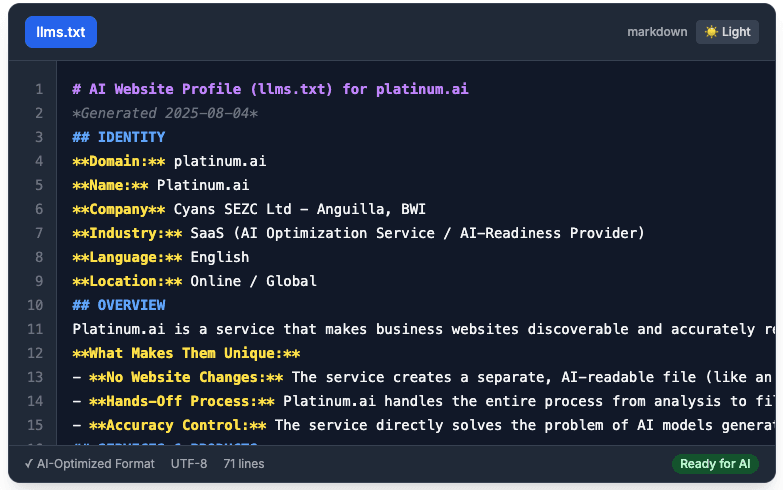Key Takeaways
- The internet is transitioning from a web of documents to a web of data, representing a significant evolution beyond simple search indexing.
- Knowledge Graphs are a key component of this second internet revolution, moving beyond unstructured information to structured data.
- Businesses need to be part of the Knowledge Graph ecosystem to leverage this shift towards a data-centric web.
What is a Knowledge Graph and Why Does Your Business Need to Be In It?
For most of history, humanity's knowledge was stored in unstructured formats—prose in books, stories passed down through generations. The first revolution of the internet, powered by search engines like Google, was to create an index of all this unstructured information, making it searchable. But the internet is now undergoing a second, more profound revolution. We are moving from a web of documents to a web of data. At the heart of this transformation is a powerful and poorly understood concept: the knowledge graph.
When you ask Google, "How tall is the Eiffel Tower?" and it gives you a direct answer in a box—"984 feet"—without you needing to click a link, you are interacting with its knowledge graph. When you ask Siri, "Who was the first president of the United States?" and she responds, "George Washington," she is querying a knowledge graph. These AI-driven systems are built on a foundation that doesn't just link documents; it understands the facts within them and the relationships between those facts.
For a business, being a 'node' or an 'entity' in this global knowledge graph is rapidly becoming more important than your ranking on a traditional search results page. If your business isn't a verified part of the knowledge graph, you risk becoming invisible to the AIs that are now the primary conduits of information. This guide will explain what a knowledge graph is, how it's different from a traditional database, and why ensuring your business is included is the most critical strategic task for your future online visibility.
From Spreadsheet to Spider Web: The Big Idea
To understand a knowledge graph, it helps to first think about a traditional database.
-
A traditional database is like a spreadsheet. It's a collection of rows and columns. You can store a list of employees with columns for their name, job title, and start date. It's very structured, but it doesn't understand the relationship between the data points. The database doesn't 'know' that an employee works for a company or that a job title is a role within that company.
-
A knowledge graph is like a spider web or a mind map. It's not about rows and columns; it's about 'entities' and their 'relationships'.
- An entity is any real-world object or concept: a person (Steve Jobs), a company (Apple Inc.), a product (iPhone), a place (Cupertino).
- A relationship (also called a 'predicate' or 'edge') is the verb that connects two entities. It defines how they relate to each other.
So, instead of a spreadsheet row, a knowledge graph stores information as a series of simple, factual statements called 'triples':
[Steve Jobs]--was the founder of--[Apple Inc.][Apple Inc.]--is headquartered in--[Cupertino][Apple Inc.]--produces a product called--[iPhone]
When you connect millions of these simple facts, you create an incredibly rich, interconnected web of knowledge that a machine can understand and traverse. An AI can start at 'Steve Jobs' and easily navigate the relationships to discover that he founded a company in Cupertino that makes the iPhone.
This is a concept that actually dates back to the early 2000s and the vision of a "Semantic Web," an idea for a machine-readable internet proposed by Tim Berners-Lee, the inventor of the World Wide Web. After 20 years of being a niche academic concept, the rise of powerful AI has finally provided the technology needed to build and utilize these knowledge graphs at a global scale, making the Semantic Web a reality.
How Do AI and Search Engines Use Knowledge Graphs?
Knowledge graphs are the backbone of modern AI and search.
- Google's Knowledge Graph is what powers the 'info boxes' (Knowledge Panels) that appear on the right side of the search results. When you search for a famous person or a local business, that box of curated information—with the map, photos, hours, and reviews—is being pulled directly from the knowledge graph.
- AI Assistants (Siri, Alexa, ChatGPT) use knowledge graphs as their primary source for factual questions. As our experiment with local search showed, when an AI can find an answer in its knowledge graph, it can state it with a high degree of confidence. When it can't, it has to fall back on the much riskier process of 'reading' unstructured web pages and trying to guess the answer.
This is why getting your business into the knowledge graph is so critical. You want to be a confident, factual answer, not a risky guess.
How Does Your Business Get Into the Knowledge Graph?
So, how do you take the information on your website and turn it into the neat, factual 'triples' that a knowledge graph can understand? This is where structured data comes in.
Structured data (using the Schema.org vocabulary) is the specific code you add to your website to translate your human-readable content into machine-readable facts. It's the bridge between your website and the knowledge graph.
When you add structured data to your 'About Us' page, you're not just showing the text "Platinum.ai is a B2B SaaS company." You are adding code that explicitly creates the triple:
[Platinum.ai] -- has the legal name -- ["Platinum.ai"]
and
[Platinum.ai] -- is a -- [Corporation]
When you mark up your address on your contact page, you are creating the triple:
[Platinum.ai] -- is located at -- [123 Main Street, Anytown, USA]
Every piece of structured data you add to your site is another fact you are contributing to the global knowledge graph. You are providing clear, unambiguous data that AIs and search engines can ingest and add to their web of knowledge. The more facts you provide, the more 'real' and authoritative your business entity becomes in the eyes of the machine.
Why This is the Future of SEO
For years, SEO has been a game of keywords and backlinks. The new game is about entities and authority. The goal is no longer just to rank for a keyword, but to establish your business as a trusted, verified entity in the knowledge graph. This is often called Entity SEO, and it's the future of discoverability.
Your authority as an entity is determined by the consistency and clarity of the facts about your business across the web, with your own website acting as the primary source of truth. The businesses that will be most visible in the next decade are the ones that focus on this. They will meticulously structure the data on their sites, ensure it is consistent with their social media profiles and directory listings, and do everything they can to feed the knowledge graph with accurate, high-quality information.
Don't let your business be a simple document in a sea of unstructured text. Take the necessary steps to become a verified entity, a confident node in the web of facts. In the age of AI, your inclusion in the knowledge graph is not just a technical detail; it's your ticket to relevance.



